How Hard Is It To Make 10 Dollars From A Blog
If you want to learn how to make money blogging, you need to ditch the cookie-cutter advice you've been reading.
"Expert" bloggers tend to give you generic advice about writing about your passions, staying consistent, forming good writing habits, and creating great content.
Then, a few years from now, you'll finally have enough website traffic to monetize your blog with affiliate programs, Google AdSense, online courses, podcasting, or selling digital products.
The hard truth is, it doesn't have to take you years – blogging advice is just outdated.
To make life-changing money from your blog as fast as possible, you need to think like a CEO and treat your blog like a business, not a hobby.
I started this blog in January 2019 to track my progress as a brand new blogger using everything I learned in the startup world.
And as you can see from my Blog Income Reports, I now make over $100,000 a month from this blog that I started just two and half years ago.
I hope this guide gives you some fresh ideas and updates your tactics for the 2020s and beyond.
Let's get started.
How to Make Money Blogging.
Before anything else, the first step is starting a blog by purchasing web hosting.
Here's my favorite beginner setup at the lowest cost with the best features (based on my 10+ years of experience):
- Click here to go to Bluehost.com (<- that link gets you a discount) and click Get Started Now.
- Choose the Choice Plus Plan.
- Enter the domain name you want to use (i.e. adamenfroy.com).
- Enter your account information.
- Under Package Information, choose an account plan based on how long you want to py. (Remember, there's a 30-day money-back guarantee with all plans, so no risk!)
- Uncheck the Package Extras (you don't need them.)
- Complete your purchase, choose your password, and login to your Bluehost account.
- Answer the onboarding questions or skip them, but choose "blog" when prompted.
- Click "skip" when it comes to choosing your theme. (We'll get that sorted out later.)
- From the Bluehost dashboard, click the WordPress button on the top right and you'll be taken to WordPress.
Congrats! You now have a self-hosted WordPress blog!
Now let's scale your new blog like a startup and make real money blogging.
Choose Your Blog's Niche Based on Market Factors, Not Your Passions.
There's a reason that 95% of bloggers fail, and it's not why you think.
The current myth is that bloggers fail because they aren't "passionate enough."
"Push through failure to succeed," they say.
Google "why bloggers fail," and you get the same answer from the #1 result: bloggers fail because they aren't passionate enough.
I officially reject this notion.
The real reason bloggers fail is the same reason that any business fails: it's not profitable.
Take my passions, for example.
I'm passionate about a lot of things – drumming, flying airplanes, traveling, astronomy, distance running, personal development, Detroit-style pizza, etc.
However, if I wrote an endless amount of blog posts about one of these topics without making any money, I'd burn out 100% of the time.
Additionally, some bloggers claim, "I'm not in it for the money" or, "It's just a hobby."
Hobby bloggers are just new bloggers that don't know how to make money yet. In any creative digital field – whether it's design, web development, photography, copywriting, or video editing – there are beginners and experts.
And since most bloggers start as beginners by writing about a passion and try to figure everything else out later, they're destined to fail.
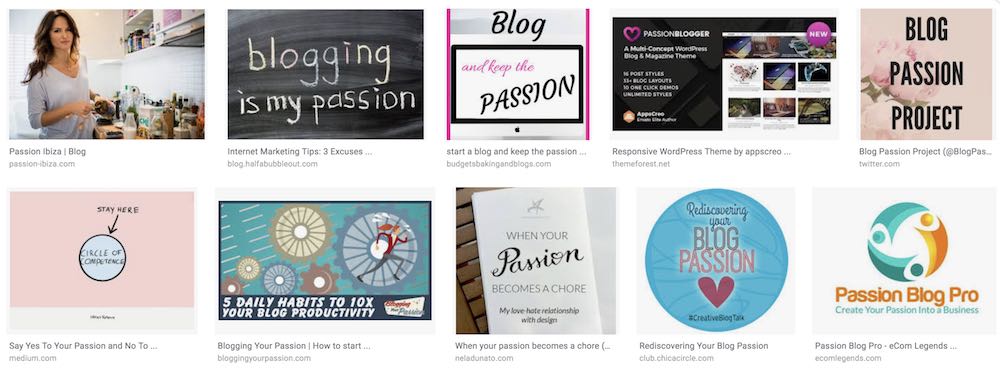
Source: Google.com
Plus, blogging advice is outdated, written only to rank on Google, and encourages a generalized approach to appeal to the broadest possible audience.
Bloggers don't fail because of a lack of passion (they have that in spades).
Bloggers fail because they can't transition from blogger to business owner.
So they choose a non-lucrative niche targeting a low-value audience. New bloggers forget to leverage networking and connections to their strategic advantage. And they don't have enough market demand to scale traffic.
I want you to succeed.
Before launching your blog, it's crucial to choose your niche based not on passions, but three business factors: audience budget potential, professional leverage, and market demand.
Check out my guide to launching a blogging business for more blogging articles.
1. Audience Budget Potential.
To offer a valuable product on your blog, you need to solve a pain point for your audience. That's obvious.
As a blogger, you should deeply understand your audience's challenges so that you can offer the most in-demand solution. Check.
Start by looking at niches where you're a member of the target audience yourself. This way, your domain expertise shines through faster.
But don't think that after you've gotten that far, you should open up a generic list of 100 niches and narrow it down that way. Watercolors? K-Pop? Travel? Good luck with that.
What is the #1 most important factor when choosing your blog's niche?
How much your audience is willing to spend.
It's that simple.
Let's break it down.
So in this example, let's say you're planning to start a blog in the home design niche.
Your blog topics may pull in different readers. Visitors could include professional interior designers, college design students, and even stay-at-home moms who want the latest home decor inspiration.
To monetize this niche, you would create a new blog and move your readers down the sales funnel:
- First, you'd create content to attract an audience
- Then you'd build out a home design "freebie" to get email opt-ins
- Next, you could use affiliate marketing to promote home decor brands
- Finally, you would offer your email subscribers a $300 online course (with a money-back guarantee) about 10 Expert Interior Design Tips for the Perfect Home
Nothing is wrong with this approach – this tends to be what most bloggers do, and it can earn some passive income after a couple of years of building your audience.
But is it a lucrative audience? Stay-at-home moms, college students, and a few professionals with an average salary?
Here's the secret.
By changing just one word in your niche, you can increase your blog's income potential by 200x.
All you do is change "home design" to "retail design."
Let me explain.
By adding a B2B component, you just shifted your audience from individuals to businesses and increased your blog's income potential by 200x.
Think about it this way. If you're selling to large businesses instead of individuals, you make more money for two reasons. The first is that they have more funds available. Second, it's not coming out of their own pocket.
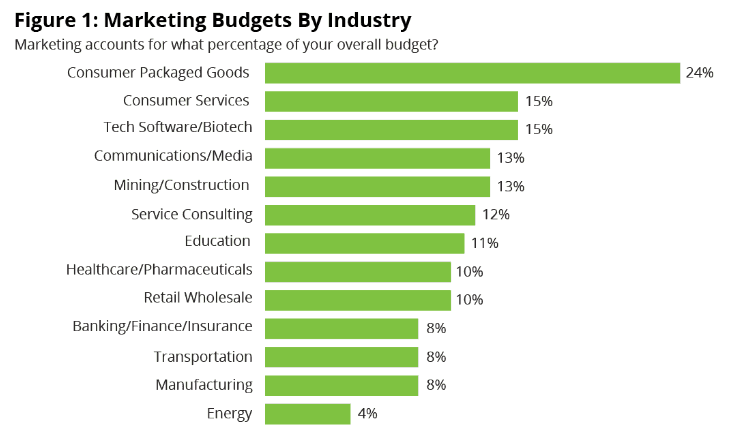
Source: imab2b.com
The beautiful thing about this approach is that your blog launch, content strategy, and sales funnel are almost the same for both the B2C "home design" and B2B "retail design" niches.
Here's the good part: while the B2C "home design" monetization stopped at a $300 course, the B2B "retail design" niche doesn't just stop there.
After you build your professional brand, you become known as a B2B design expert. This influence allows your price to jump from a $20 affiliate commission or a $300 course – to a $5,000/month recurring consulting service.
Understanding your audience's pain points isn't enough.
To 200x your revenue potential, your audience needs to be in a lucrative B2B niche and pay a monthly recurring basis.
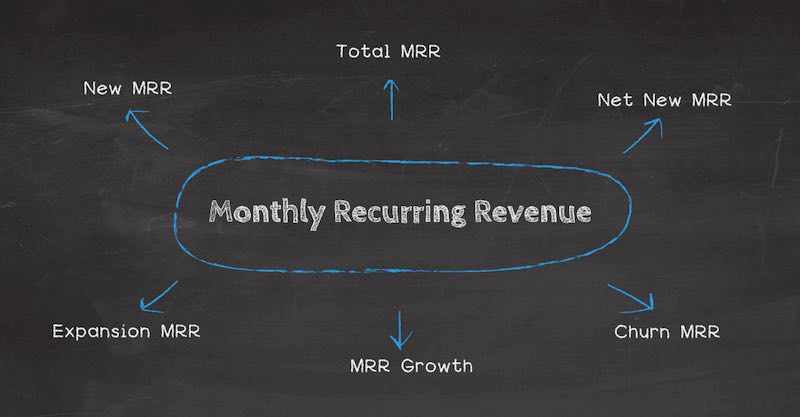
Source: Datapine.com
To recap, when choosing your niche, rather than worrying about your passions and getting thousands of passive, low-value site visitors, focus on closing 2-3 high-value clients.
With this approach, I hope you're beginning to understand why I truly believe you can make $10,000/month in 90 days with a new blog.
2. Use Your Professional Leverage to Choose Your Blog's Niche.
After uncovering a lucrative audience to provide value to, the next step is to discover the strategic advantages you may have over others.
Ask yourself:
- What is my current level of professional experience?
- What connections do I have in my industry?
- Can I leverage this experience into a profitable blog?
- If I could pitch any website in the world to contribute a guest post, who would take me seriously from the start?
To build a truly successful blog, you first need to build influence. And to build authority, you need to step outside of your comfort zone and leverage your connections, professional experience, and everything at your disposal like never before.
You will also be performing a lot of outreach to make new connections.
Outreach includes building relationships so you can guest post on authoritative sites in your niche. These posts give you get relevant, high Domain Authority (DA) backlinks for SEO, which is still one of the best ways to rise in the Google search rankings. And according to Broadband Search's recent Internet statistics from 2019, Google process 3.5 billion searches per day – or over 40,000 every second. There's plenty of traffic to go around.
And when you're just starting, you may not have many connections or published content out there. You might say: "Why would anyone feature me?"
Leveraging your background helps tremendously.
For example, if you're a photographer, you might have a base of clients, contacts from local meet-up groups, and even know photography influencers that you met in the past. If you can leverage these contacts in the future, you can accelerate the growth of your blog.
3. Your Niche Needs Market Demand.
Before you get started, you need to do some research and see if people search for the topics you want to write about – and they are monetizable.
The two main types of monetizable keywords are "best" list posts and "how-to" guides.
These two main types of keywords have the most affiliate marketing revenue potential.
For example, in the case of the "best" list posts:
- In travel, this could be "best travel insurance" or "best travel backpack."
- In finance, it could be "best savings accounts" or "best Roth IRA."
- In tech, it could be "best VR headset" or "best PS5 exclusives."
When people are searching for the "best" something, they are looking for long-form guides recommending products that are written by bloggers. Most of these will have good affiliate programs to join and promote.
In the case of "how-to" guides, these could be:
- In marketing, how to make a website.
- In lifestyle, how to decorate your kitchen.
- In health, how to get rid of acne.
These how-to guides are long-form tutorials packed with high-quality content. These are also good for adding affiliate links.
Once you understand your leverage and passions, take your chosen niche, and come up with the top 10 keywords to target.
Next, use a keyword research tool like GrowthBar, Google Keyword Planner, SEMRush, or Ahrefs and enter your keywords.
With GrowthBar, you can do your keyword research right while you're searching on Google.
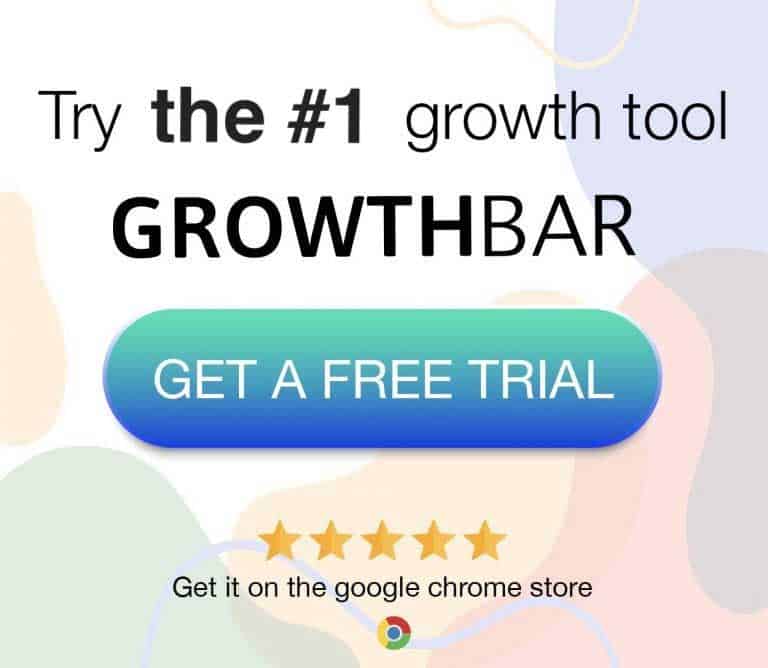
Here are some strategies to keep in mind when it comes to keyword research.
If your top 5 keywords have search volumes of at least 5,000, this shows that there is interest in these topics. Here's an example of my target keyword in this blog post:
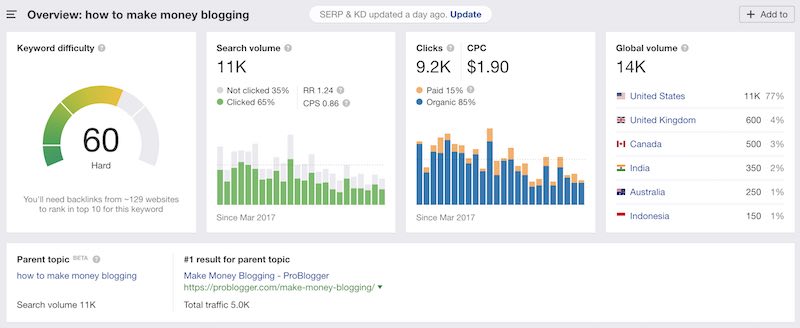
After that, look at the keyword difficulty score (a number from 0 to 100 on how difficult it will be to rank for the keyword).
If your keywords have difficulty scores of 80 or higher, the competition may be too fierce for you to make an impact.
Shoot for target keywords with over 2,000 monthly searches and under a 50 difficulty score so that you can potentially get more traffic with less competition.
Another way to view competition is to use an SEO tool like Ahrefs to see search engine results page (SERP) data. Specifically, look for the Domain Rating (DR) of the first page results and the SERP position history.
If the top 10 results all have a DR over 70, your new blog with a DR of 0 is not going to get on page one, thus getting no traffic.
However, if you see a website with a DR under 50 on page one, that's a good indication that you can outrank them over time with quality content.
Lastly, if the SERP position history hasn't budged over the last six months, that means that positions #1 – 5 have stayed in the same spot. In these cases, the competition may be too intense for that keyword.
To recap, when researching your blog's market demand, shoot for topics that have keywords with:
- 2,000+ monthly searches
- A keyword difficulty score under 50
- The first page of Google has at least one site with a DR under 50
- A SERP position history that has changed recently.
To summarize, focus less on writing and more on keyword research – every single blog post needs to target one keyword.
Make sure to choose your niche based on audience budget potential, professional leverage, and market demand.
Find an audience that you're a part of and understand their challenges personally. Up-level that audience to make sure there's a B2B component to 200x your revenue potential. Leverage your network, job experience, and everything else at your disposal. And make sure your niche has market demand.
Because in the end, passion doesn't create money; money creates passion.
Ready to get started? Try Bluehost for $2.95/month (63% off) with my link.
Scale Your Content Creation and Stop Writing So Much.
What if I told you that your blog's first 90 days has nothing to do with your blog and you won't write a single word?
What if the secret to scaling and making money blogging doesn't include blogging?
What if everything taught about growing a new blog has limited your growth?
Remember: you're a business owner, not just a blogger.
From days 0 to 90, you shouldn't be focusing your energy on writing first drafts. I won't give the same old, outdated advice. I refuse to talk about how to write about your passions, follow an editorial calendar, writing habits, writing consistency, (or anything about writing for that matter).
Instead, we're going to scale your blog like a startup and build credibility in your niche faster.
One big way to do that is to get writing help. Instead of writing every single first draft yourself, you can use a service like Fiverr to find freelance writers. There are plenty of writers that provide blog post writing services so that you can spend your time editing, publishing, and link building.
Overall, there are five main components to this process:
- Outreach
- Guest Post
- Outsource
- Backlinks
- Repeat indefinitely
By using this system for the first year after launch, my blog received over 5,000 backlinks from 1,000+ domains and a +74 Domain Rating (DR) increase.
Most importantly, I continued to see huge year over year gain in traffic:
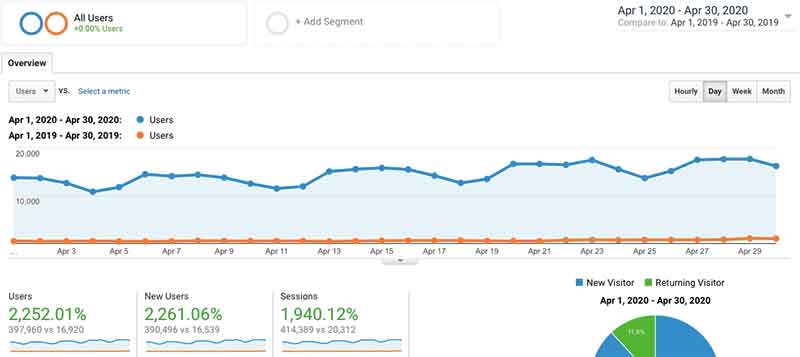
If you're a blogger that wants to focus on writing, consistency, passion, and habits, you can stop reading here.
But if you're one of the like-minded people that's serious about growing your blog like a CEO (and not a hobby blogger), let's start monetizing.
1. Relationships Are Your Foundation.
Before you start building relationships with other bloggers and influencers in your niche, you have to understand one central theme. You have to provide value to others. Don't go into the process of building a relationship just thinking about what you'll get out of the deal. First, you need to focus on the benefits you'll give others.
Ask yourself: what value are you providing in the relationship?
- Could you provide content because your expertise matches their audience's interests?
- Is their blog currently in need of content to fill their editorial calendar?
- Can you leverage link building for them in other guest posts you're writing?
- Is there a topic that you're well versed in that doesn't exist on their blog?
The first step in pitching is understanding your value and what you can do to help. This information will be vital in your initial email outreach strategy.
First, create a targeted list of sites.
Once you understand the value you can provide, it's time to start building your blog outreach list. This list should be a simple spreadsheet with five columns: Website, Name, Email Address, Status, etc.
To begin populating your spreadsheet, look up the target blog's monthly site visitors and Domain Authority (DA) by plugging their URL into an SEO tool like Ahrefs. Aim for blogs with a Domain Authority of 50+.
Remember, the higher the DA, the stronger the partnership potential, and the more SEO impact you'll receive from the relationship. To save time during your search, find an article like this one with the top blogs and websites accepting guest posts, with Domain Authority scores.
Once you've pared down your list of blogs based on the criteria above It's time to find the right person to contact.
First, use LinkedIn.
Start by filtering your search results by the blog's company page, then within the company, search for people by using terms like: "Content Manager," "SEO Manager," "Editor," or simply, "Content."
After you find 2-3 potential contacts, connect with them on LinkedIn. 2nd degree LinkedIn connections are better than 3rd – and if you have a mutual contact, even better. Don't spend too much time on your connection message either, often your text gets buried or comes off as spammy.
Once you've reached out on LinkedIn, use an email tool like Hunter.io to scan the blog for email addresses. Even if you can't find the contact's exact email address, Hunter.io shows your email structure, such as firstname@blog.com or firstname.lastname@blog.com. Add this contact information into your spreadsheet.
2. Start Relationships & Pitch Guest Posts at the Same Time.
Valuable blogging relationships provide content and links. Once you have a list of 50-100 potential contacts and have reached out on LinkedIn, it's time to start your email outreach.
You can scale your guest blogging strategy by using an email template to start the relationship while asking to guest post at the same time.
Here's a sample template that I've used:
Hey (First Name),
My name's Adam and I'm the (Title) at (Blog).
I'm reaching out because I love (Target Blog) and am interested in collaborating on content with you.
I was curious if:
1) You'd like to participate in link building. I write (X-X) guest posts per month and would be happy to link to your site in my content.
2) You allow guest posts on your blog.I'd love to contribute to your (awesome? informative? useful?) blog and can pitch some topic ideas that I think your audience will enjoy. Here are some recent samples from me:
(Sample 1 URL)
(Sample 2 URL)
(Sample 3 URL)Please let me know if you're interested and I look forward to hearing back from you soon!
Thanks,
Adam
That's it.
By using a guest post email template and knowing how to start an email greeting, you save time and scale your process by starting a relationship and pitching a guest post at the same time.
Once your contact responds to your email and says they are interested in a guest post, you need to pitch the perfect topic.
There are four main criteria for the perfect guest blogging topic pitch:
- Your content doesn't exist on their site yet. When you have a topic idea, go to Google and search "site:blog.com topic" to scan their blog to check if it already exists.
- Your topic and target keywords have SEO value. Go back to Ahrefs and input the blog's URL. View which organic keywords are driving the most traffic to see if you can find gaps in their content that you can fill.
- The topic matches your expertise. You should be able to write intelligently about the subject and use the guest blog to build more influence in your niche.
- The topic matches the audience's interests. Check their editorial guidelines, look into how they write their blog posts, and try to match their blog's style.
Once your topic is accepted, you can move onto the heart of your guest blogging strategy.
3. The Importance of Guest Blogging.
In January 2019, I conducted a guest blogging experiment. My goal was to contribute as many guest posts as I could within 15 days to measure its impact on my site's SEO metrics and traffic.
Here were the results after 15 days:
- Eight guest posts published on websites with DAs of 81, 73, 60, 66, 71, 61, 94, and 84
- 32 new referring domains
- 247 new backlinks
- 268 new organic keywords ranking in the top 100
- 372% increase in organic traffic
- +12 to Ahrefs Domain Authority
- Alexa Rank improved by 600,000
The results were clear – guest posting on high DA sites still greatly impacts a new blog's SEO. With 65% of marketers saying that link building is the toughest SEO tactic to master, it can also be the most rewarding.
That's why I recommend launching a blog with 5 "pillar posts" – long-form, SEO-optimized articles built for inbound links. Add statistics, infographics, and case studies to making linking easier.
Even as my blog ages, I still aim to contribute at least one guest posts for every post I write for my blog.
Remember, when you're first learning how to make money blogging, focus more on the business and relationship side of things and less on writing.
However, the content quality of your guest posts is important. Make sure to properly use headings, paragraph text, and links to your content. Follow the guest post guidelines closely and use one of the best grammar checker tools if you want to improve the quality of your writing.
Update 2020: In 2019, I published over 80 guest posts, increased my Domain Rating to 74 and now (as of May 2020) get over 400,000 visitors/month to my blog.
Update 2021: I continue to publish guest posts, have increased my Domain Rating to 78 and grew my blog to over 500,000 monthly visitors.
Disclaimer: This article includes affiliate links which may provide a small commission to me at no cost to you. However, these are the best tools to help you make money blogging this year. You can read my affiliate disclosure in my privacy policy.
How to Monetize Your Blog the Right Way.
There are a lot of options when it comes to making money blogging – affiliate marketing, ads, online courses, one-on-one coaching, consulting, sponsored posts, selling physical products, etc. Some of these income streams require more traffic than others.
That's why it's essential to plan your future revenue-driving strategy with the right forms of monetization at the right points in your blog's lifecycle.
1. Plan Your Future Blog Monetization Timeline
For example, if you just created a new travel blog, it doesn't make sense to put ads all over your site. Those tactics require hundreds of thousands of monthly visitors to make good money.
Similarly, you shouldn't start affiliate marketing and cram a bunch of links everywhere at the beginning either. Generating affiliate marketing revenue can also require thousands of visitors to make a single sale.
Yes, you can eventually get a place where you're generating "passive income" with affiliate marketing, courses, ad revenue, and digital products, but that can take years.
What if you want to start making money from your blog to quit your job in 3 months?
The good news?
The most lucrative form of blog monetization can be used from Day 1 and doesn't require much traffic.
Your perfect blog monetization timeline will focus on maximizing revenue in each stage of your blog's growth.
There are four distinct areas of focus:
- 1-90 days: High-end consulting (0-1,000 monthly site visitors)
- 90-180 days: Affiliate marketing (1,000-2,500 monthly site visitors)
- 180-365 days: Your first online course (5,000+ monthly site visitors)
- 365 days and beyond: Course memberships (10,000+ monthly site visitors)
It may seem counter-intuitive to start with consulting if you're a brand new blog without much traffic. However, because you're building relationships and treating your blog like a business, you can land high-end clients from day one.
This post will first focus on days 1-90 and how to perfect your high-end sales funnel to make money blogging from the start.
Ready to get started? Try Bluehost for $2.95/month (63% off) with my link.
2. Master Your Blog's Sales Funnel
Your sales funnel will be comprised of 5 primary areas leading users down the path to your end goal of a high-end $3,000+ consulting offer. As you scale up traffic, you can focus on lower-priced offers like online courses, affiliate products, sponsored posts, and digital downloads. However, the most lucrative way to monetize a new blog is with an expensive offer from the beginning.
It's a simple balancing revenue act as you grow your traffic. The newer your blog and the less traffic you have, the higher your price needs to be to compensate:
Low Traffic x High Price = High Traffic x Low Price
Here are the five steps to get prospects down your sales funnel:
- A user reads your high-quality blog content related to your high-end offer
- They opt-in for your email list for a one-page "freebie" offer
- Optional: Add a lower-priced offer around $50-200 to build trust (we will add this down the line)
- Your automated welcome email series tells a story and take them down a path to set a meeting with you
- Finally, your ideal B2B clients set a meeting with you and pay for your high-end consulting offer
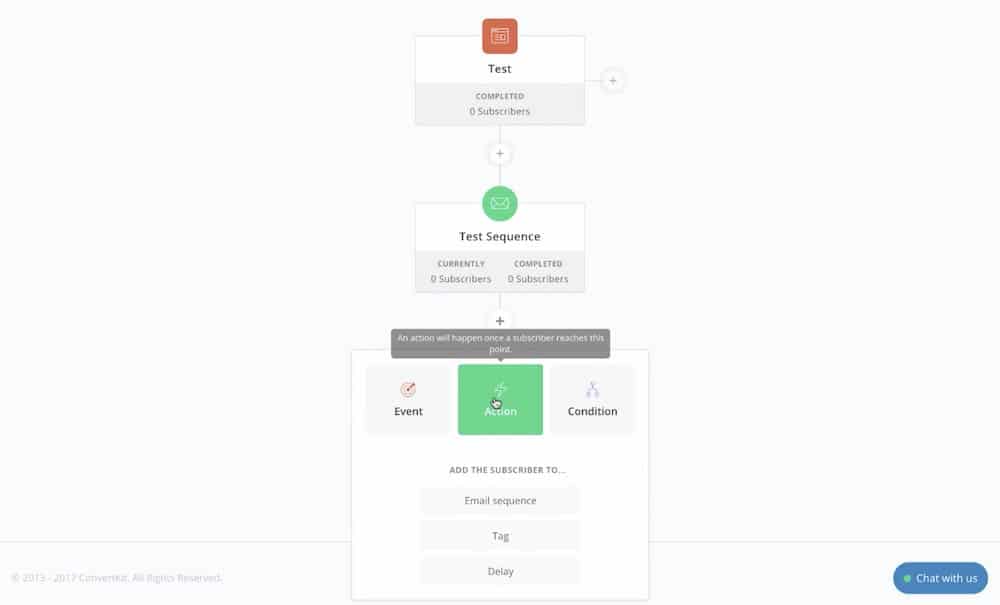
For a brand new blog, all that you need is your first five blog posts, a one-page opt-in "freebie," an email platform and list, and a consulting page.
I'll repeat it: you're a business owner, not a blogger.
Think about all those local business websites that look like they're straight from 1996 – auto mechanics, financial services, real estate sites, etc. They might be lucky to get a few hundred visits/month. But their website is bringing in revenue because they're filling a need in the market and providing a solution with high-end services.
Your blog must have a service that fills a need in the market from day one.
The early focus of your new blog isn't to write a bunch of blog posts that no one will find. Instead, focus on having just five high-quality pillar posts, a consulting page, and a dialed-in sales funnel. Your sales outreach will do the rest.
3. Master Your High-End Consulting Offer
As we discussed, when choosing your niche, you need to have a dialed-in sales funnel with the end goal of converting $3,000+ sales to business clients.
From day one, your goal to make money blogging should be driving traffic to your consulting page. This page needs to be in your top-level navigation, and include keyword research around the terms that your high-end business clients type into Google.
Make sure the page has a professional picture of you and easy ways to contact you.
Your Home page, Start Here page, About page, and blog posts should strategically link to your Consulting page. Also, when contributing guest posts, you should add a link to this page in your guest author bio. Here's what mine looks like with links in bold:
Adam Enfroy is a content marketing consultant and blogger. He lives in Austin, TX, and writes about how to blog like a startup at adamenfroy.com.
4. Use The Magic Email Opt-In Formula
When building your sales funnel, you need to use email marketing software coupled with an on-site email opt-in tool to generate the most email subscribers.
What's the magic formula?
ConvertKit + OptinMonster
ConvertKit is the best email marketing tool for bloggers.
It's great for a few main reasons:
- You can create advanced email sequences based on different site actions to personalize your funnels. Note: 59% of customers say that personalization influences their shopping decision
- Next, you can create drip campaigns and link sequences together based on actions inside of emails.
- Finally, it's perfect for bloggers because their text emails look professional and don't have annoying branding like with MailChimp and other platforms.

Remember, simple text emails will generate the most revenue for your blog. Don't worry about fancy design features, adding your logo, or a bunch of images.
Think about it. If a sales professional was trying to close a $3,000 deal, what kind of email would they send? It would be a text-based email based on a healthy relationship, not an impersonal, image-heavy marketing email.
In unison with the email platform, OptinMonster is the best email opt-in tool out there. It's a WordPress plugin that you can easily integrate with your blog (and ConvertKit) to generate more email subscribers.
With OptinMonster, you create different types of opt-ins, including exit-intent pop-ups, sidebar opt-ins, and even forms within your blog posts themselves. I have one exit-intent pop-up, one sidebar opt-in, one on specific pages, and one at the end of blog posts.
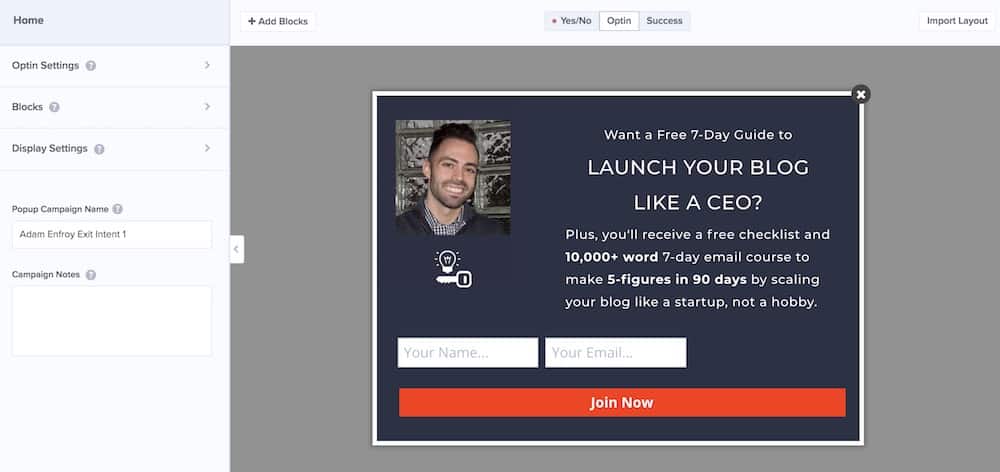
With these email opt-in types on your blog, you are maximizing the number of potential visitors entering your email funnel and converting your visitors into customers.
5. Aggressively Focus on Affiliate Marketing
Affiliate marketing is my absolute favorite form of blog monetization.
If you look at all of the most profitable blogs, pretty much all of them are great at affiliate marketing.
And to be a successful affiliate, you need to rank for keywords on Google and mediate purchase decisions. It looks something like this:
Google => Your Blog => Purchase.
Confused? Let's look at a few examples.
NerdWallet is a huge affiliate in the finance niche. When you Google "best credit cards", you always see them at or near the top of the SERPs:
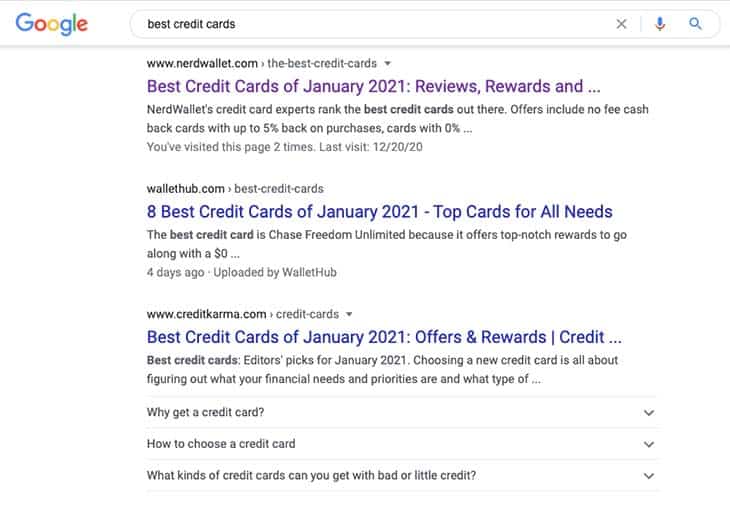
When you click their link and visit their site, they provide a list of the best options, with affiliate links to purchase the cards:
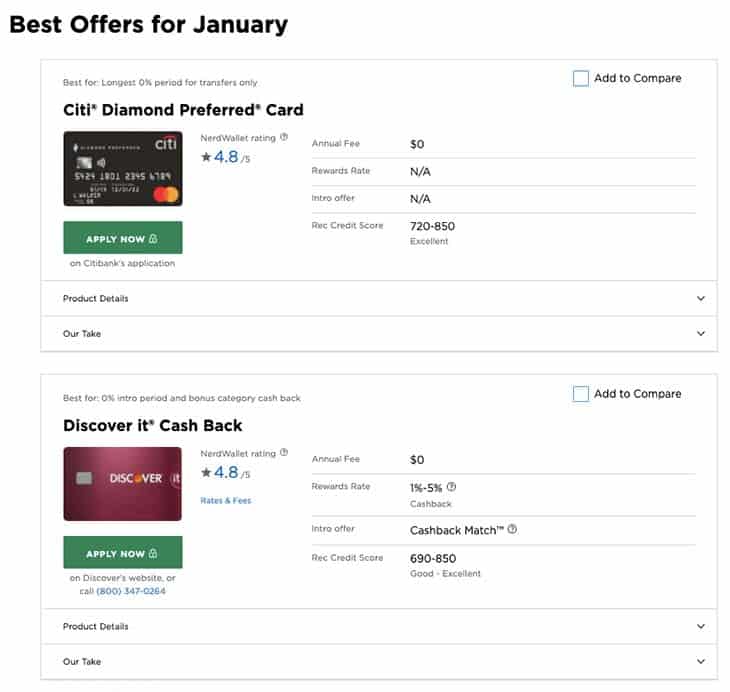
There are 41 options laid out on the page, with a block of optimized content underneath to maximize their SEO.
When a user decides to click on one of the "Apply Now" affiliate links, they are redirected to the companies offer page, and NerdWallet gets a commission on each sale.
As "best credit cards" is searched 182,000 times per month, this page is a money-printing passive income machine.
Let's look at another example.
What if I search for "best laptops."
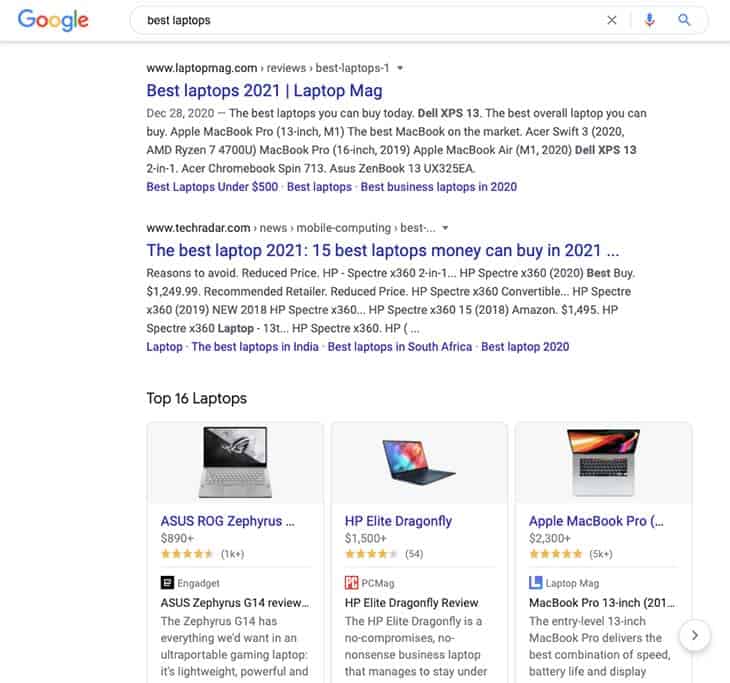
We see Laptop Mag and TechRadar in the first and second positions – both affiliate blogs.
When we click on Laptop Mag, what do we see? Another list post recommending products with affiliate links:

Again, if a reader clicks the "View at Dell" button, they are redirected to the product page on Dell.com via an affiliate link, giving Laptop Mag a commission on every sale.
As "best laptops" is searched 112,000 times per month, this post is another passive income machine.
Did you notice something interesting when we made these Google searches?
There wasn't a single actual company that sells the products ranking for these terms. There was no Capital One or Discover ranking on page one – just affiliate blogs. There was also no Dell, Best Buy, or HP ranking for "best laptop" – it was all blogs.
Why is that?
When searches are looking for "best" products, they want comprehensive review posts, not product pages.
They're not ready to buy yet. They want to read a long-form review comparing the different options.
This is how blogs make money. They are search intent mediators. They bring in traffic via search engines, provide advice, and get people to click affiliate links.
It's that simple.
So how do you get started?
You need to start writing blog posts that are transactional in nature.
Remember, your blog is a mediator. You need to assemble content that can make you money and drive purchases, not aimless informational articles that can't be monetized.
How Much Money Can You Make Blogging?
Bloggers are making money in all kinds of ways. Successful bloggers can make over 7-figures/year, while other bloggers might be generating no income at all. A goal that many bloggers tell you to shoot for is $2,000/month in recurring income within one year. However, with my monetization strategies below, I made $17k of monthly recurring revenue in the first 90 days.
So let's start monetizing your blog.
You've chosen your blog's niche, outsourced your content, and planned your blog monetization timeline. It's time to learn how much money you can make blogging in 90 days.
Before you tackle this plan, you will need:
- A WordPress blog – make sure to get started with Bluehost.
- Five pillar blog posts you want to promote.
- All web pages complete: About Page, Start Here Page, Contact Page, Consulting Page, Resources Page, Email Opt-In Page, etc.
- Email marketing software set up with opt-ins in your sidebar, in blog posts, and upon exit intent.
- An active email sales funnel with a welcome email series – using ConvertKit and OptinMonster.
- A content marketing writer or freelancer ready who will help with your guest post pipeline.
Once you have these covered and launch your blog, your 90-day blog monetization plan can begin.
You'll notice that this plan to make money blogging consists of almost 100% outreach.
Since you have your original content, sales funnel, and blog posts published, you maximize impact by building relationships and getting backlinks.
The main outreach targets include influencer relationships, your professional network, your high-end client personas, and blogging communities.
It's time to scale your blog like a startup in 90 days.
Let's earn some real, life-changing money blogging.
Week 1
Goals: Begin influencer outreach, get five guest post topics approved, get 2nd tier professional connections, join communities on a blogging platform.
Tactics:
- Influencer Relationships
- Create the spreadsheet list of 100 high DA sites you want to partner with
- Find contact information and email addresses of proper contacts
- Begin LinkedIn outreach with template
- Begin email outreach with template
- Get five guest post topics approved
- Have a content team begin writing and add in your links/target influencer links
- Professional Network
- Get a list of 2nd tier contacts in your niche from your network
- Reach out to them, tell them about your blog, and figure out ways you can provide value to them
- High-End B2B Client Personas
- Build a list of 50 ideal B2B customer personas for your high-end consulting services
- Join Blogging Communities
- Join communities on blogging platforms, Facebook, LinkedIn, local meet-ups
Weeks 2-3
Goals: Get the first two guest posts published, get approved to contribute five more guest posts, outreach to high-end B2B client personas.
Tactics:
- Influencer Relationships
- Get first two guest posts published under your name
- Continue outreach and get accepted to contribute five more guest posts
- Outreach to target influencers you linked to in your two published posts
- Professional Network
- Meet with 2nd tier contacts you were introed to, see how you can provide value
- High-End B2B Client Personas
- Outreach to list of 50 ideal B2B customer personas to ask about business and pain points
- Blogging Communities
- Reach out in your niche, introduce yourself, and see how you can provide value
Week 4
Goals: Outreach to high-end B2B client personas, get two more guest posts published, begin link network.
Tactics:
- Influencer Relationships
- Get two more guest posts published (4 published, 6 in progress)
- Share posts on social media and with network
- Outreach to influencers that you linked to in guest posts
- Leverage current influencer relationships to create link building network
- High-End B2B Client Personas
- Follow up with your list and offer to set up a meeting
- Meet with and practice four sales meetings with your high-end B2B client personas
Reminder: this blog post covers the first four weeks to help you make money blogging. If you want a free 10,000+ word email course, a 7-Day Blog Launch Checklist, and your full 90-day plan to make $10k, you can sign up for my email list below.
To recap how I want you to think about how to make money blogging, look at it this way:
To earn $10,000 in monthly recurring revenue from your blog, you either need to:
A. Sell 200 affiliate marketing products at $50 per sale every month. Or B. Close 3-4 high-end consulting deals. Which is easier? The affiliate marketing option may require 25,000-50,000+ monthly site visitors; the consulting option only requires a little expertise and a sales funnel.
Ready to make money blogging? Try Bluehost for $2.95/month (63% off) with my link.
Disclaimer: This article includes affiliate links which may provide a small commission to me at no cost to you. However, these are the best tools to help you make money blogging this year. You can read my affiliate disclosure in my privacy policy.
How to Make Money Blogging FAQ.
Can you make a living blogging?
Yes, you absolutely can make a living blogging and it can be very lucrative. However, the harsh truth is that the vast majority of bloggers do not make enough money to support themselves. I launched this blog in 2019 and as you can see in my Blog Income Report, I make over $80,000 per month from this blog.
How do beginner bloggers make money?
If you're just starting out, it can take a little bit of time to start accumulating an income. During the early days, bloggers should offer consulting and coaching services to earn a higher income in exchange for their time. Since traffic levels are low at the beginning, turning those visitors into customers with a higher-priced offer makes the most sense.
After you have some steady consulting income rolling in and traffic levels increase, bloggers can then add affiliate links, digital products, and ads to their blog.
How much money do bloggers make?
The amount of money that bloggers make varies widely. According to a ProBlogger Report, earnings per month are broken out as follows:
1. Almost 38% of bloggers make less than $10.
2. 10% of bloggers earn between $10 and $99.
3. 17% of bloggers earn between $100 and $499.
4. 7% earn between $500 and $999.
5. 9% earn between $1,000 and $9,999.
6. 4% earn $10,000 or higher.
Do bloggers pay taxes?
Yes, bloggers must pay taxes on their income, regardless if they're an LLC, S Corp, or sole proprietorship. Different income streams require different tax liabilities.
For example, if you sell products on your blog, you need to collect sales taxes only if your customer lives within your tax nexus (in the US, this is typically the state you reside in). Most ecommerce platforms take care of these calculations for you.
If you generate income from affiliate programs, the companies you are promoting treat you as a 1099 independent contractor.
No matter your entity type, you need to use accounting software and keep a good record of your books for tax season.
Do I need an LLC for my blog?
The short answer is no, you don't need an LLC to run a blog. You can start out as a sole proprietor and include your income with your personal taxes. However, once you start making a sizeable income, there are tax advantages to creating an LLC or S Corp.
Who is the richest blogger?
Arianna Huffington of the Huffington Post is the world's richest blogger. She founded her company in 2005 and now makes over $2 million per month from her news website.
Another wealthy blogger is Michael Arrington, the founder of TechCrunch. He brings in around $800,000 per month from his technology blog.
Summary.
By selecting your niche based on market factors and B2B components, you 200x your blog's revenue potential.
By scaling your content strategy, conducting ongoing SEO site audits, and outsourcing aspects of your writing process, you 200x your backlink acquisition and Domain Authority (DA).
Finally, by choosing the right high-end blog monetization strategies from Day 1, you can make life-changing money as a blogger within 90 days, not five years.
Using these tactics in the first year of my new blog, I started making $35k/month by month 9, got 7.1k backlinks from 1,000 new referring domains, increased my Domain Rating from 0 to 73 and my traffic from 0 to 250,000+ readers/month.
I hope this article helped you learn how to make money blogging. Join my email list for my full 2019 blog income report where I highlight how I made $203k in my blog's first year and $812k in my second year.
Recommended Resources on AdamEnfroy.com: If you're interested in learning more about blogging, check out my ultimate guide to learn how to start a blog, the best web hosting companies, and take a deep dive into my guest blogging and outreach strategies.
How Hard Is It To Make 10 Dollars From A Blog
Source: https://www.adamenfroy.com/how-to-make-money-blogging
Posted by: juddwrick1979.blogspot.com

0 Response to "How Hard Is It To Make 10 Dollars From A Blog"
Post a Comment